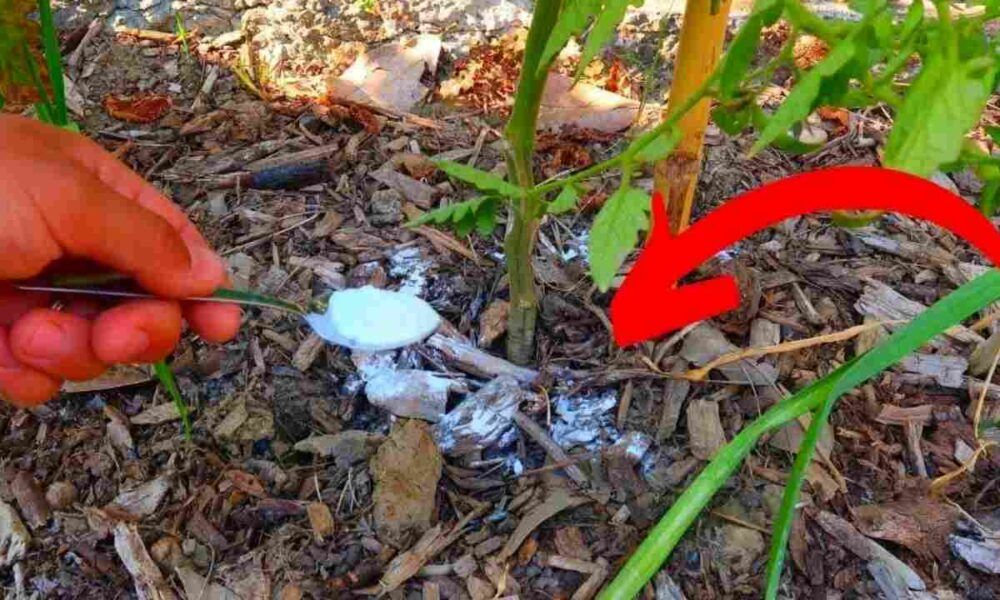Why should we put baking soda on plants? There’s a very specific reason why we should always do this.
Il sodium bicarbonate it is a versatile product that can be found in every home. It excels in performing a wide range of functions, including cleaning various surfaces and effectively softening dried vegetables.
It also provides relief as a digestive aid after consuming a particularly heavy meal.
Many people are unaware that bicarbonate can be a valuable tool in the ecological protection of vegetable gardens, orchards and plants.
Its effectiveness is particularly evident in its ability to combat powdery mildew, a common pathogen that affects a variety of plants including grapevines, zucchinis and sage.
In agriculture, there are two distinct forms of bicarbonate: sodium bicarbonate and potassium bicarbonate.
While these compounds are similar in nature, they serve specific purposes, especially in the fight against fungal diseases.
Their properties make them an optimal choice for organic farming, as they offer an effective fungicidal treatment.
Finding baking soda is an easy task, and it’s an affordable option too. Plus, it’s an ideal choice for both family and home gardens for normal gardens.
Now, let’s explore the distinctive features of baking soda and compare it with potassium bicarbonate.
In addition, we will discuss the appropriate situations for its use and suitable methods to conduct the treatments.
Potassium bicarbonate and sodium bicarbonate
When it comes to bicarbonate, it’s important to distinguish between baking soda and potassium bicarbonate.
Although these two compounds share similaritiesvary both in their molecular structure and in the official classification for them agricultural applications.
Sodium bicarbonate, chemically known as the sodium salt of carbonic acid, is a fine white, odorless powder that can be dissolved in water at room temperature.
It is derived from the combination of soda ash, water, and carbon dioxide. In agriculture, sodium bicarbonate is classified as “invigorating” and is considered an enhancer of the natural defense mechanisms of plants.
Put bicarbonate on a map-ilcorrieredellacitta.com
This classification is specified in Annex 2 of the new Ministerial Decree 6793 of 07/18/2018, which integrates the existing European legislation governing the organic sector in Italy.
Potassium bicarbonate is a derivative of carbonic acid, specifically derived from potassium carbonate.
Unlike baking soda, it is primarily considered a pesticide rather than a tonic. As a result, it falls under the jurisdiction of existing pesticide regulations.
Fortunately, its effectiveness is limited to just one day, allowing you to carry out the treatment before fruit ripening.
It is important to note that the term “ripe” refers to the designated time interval, measured in days, between final treatment and harvest.
If professional farmers have the necessary “license”, a document issued at the end of a specialized training course, they can use pesticides.
Conversely, hobbyist farmers currently do not require such permission and have access to product formats other than those intended for professional use.
However, since the entry into force of the NAP (National Action Plan) in 2015, which effectively regulated and restricted the entire pesticide industryEven in conventional agriculture, the range of products available for private purchase has significantly decreased.
Consequently, this has limited the imprudent use of harmful, polluting and health-damaging substances.
In this way, people are encouraged to opt for more environmentally friendly alternatives when taking care of their vegetable gardens, orchards and lawns.
Why put baking soda on plants?
There are two variants of baking soda that serve the purpose of safeguarding plants against certain fungal or cryptogamic ailments.
By raising the pH of the liquid solution, the presence of bicarbonate generates unfavorable circumstances for the growth and expansion of harmful fungal mycelia.
Bicarbonate on plants-ilcorrieredellacitta.com
This, in turn, leads to their dehydration and the subsequent prevention of further spread.
How the treatments should be carried out
In order for the treatments that use the two variants of bicarbonate to give the desired results, it is essential that the intervention takes place promptly, as soon as the first signs of the disorder appear.
The effect is essentially preventive and it serves to inhibit further progressionbut does not possess the ability to restore plants that have already suffered significant damage.
The use of sodium bicarbonate depends on the desired concentration, which ranges from 500 g to a maximum of 1500 g per hectolitre of water.
These recommended amounts are applicable to large areas employing spreading machines, but the same proportion also applies to small-scale crops.
For example, when preparing a solution in a 1 liter spray bottle, it is recommended to include 5-15 g of baking soda. Conversely, using a 15 liter knapsack pump, the ideal amount would be approx 75-225 grams.
When using plant protection products of any kind, whether they are environmentally friendly or not, it is essential to stick to the recommended dosage.
Even seemingly harmless substances such as baking soda can cause burns if applied excessively and can lead to a pH increase if accumulated over time in the ground. Similar problems arise with excessive use of potassium bicarbonate.
When it comes to potassium bicarbonate, the commercial product label provides recommended dosages for various species (although there may be variations) and the necessary usage precautions.
To guarantee the effectiveness of the treatments, it is essential to carry them out during the cooler periods of the day.
It is particularly important to avoid treating plants when the ambient temperature exceeds 35 °Cas this could potentially result in a harmful effect on plants known as phytotoxicity.
This limitation presents a challenge when combating powdery mildew in cucurbits during the summer, as even i sulfur treatments may not be sufficient at extremely high temperatures.
In such cases it is necessary to wait patiently for the cooler days and in the meantime remove the most affected leaves.
